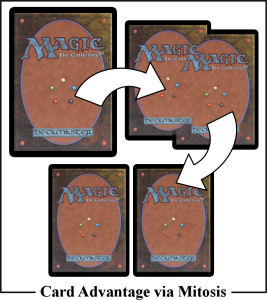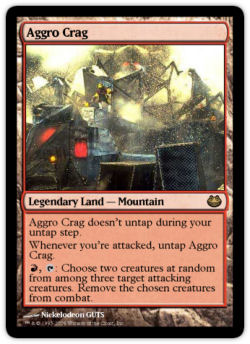I loved the idea of having Pro Tour Prague right after the Dissension prereleases. It makes sense: usually, Constructed Pro Tours are scheduled to have a new metagame – after a set’s rotation, or stand-alone releases or after bans – so a Limited Pro Tour should also have an unexplored metagame, and not have players make their picks on autopilot.
My friends and I played in lots of prereleases to get the maximum number of Dissension packs possible. In between the prereleases and Prague I played in eight drafts. I wish they could’ve been more, but it’s hard to convince seven other unqualified guys to draft daily on weekdays. Anyway, together with the two drafts at the Pro Tour plus some more side-drafts that I did afterwards, I’m starting to get a feeling of the format.
When we start drafting here in Portugal it became clear that the average player forced Blue. Usually we had five Blue drafters in an eight-man pod. It’s not hard to understand why: In the Dissension prereleases everyone played Blue – perhaps because two out of three guilds in Dissension include Blue. Right now, Blue is hyped: everyone knows that Blue might be the best color. Blue cards are like sports players from a team who just won some major league (for example, soccer and the Euro Champions League). Just like those players being transferred for a price much higher than their value, the Blue cards are being picked much higher than they warrant, with Vedalken Dismisser first pick being the best example.
I like to reduce things – even if sometimes they’re complex, like RGD drafts – to simple forms, as they provide a better understanding. In this format I can identify three major types of draft decks, even if sometimes the final result is a hybrid between these styles.

- Inherent card advantage (usually the Blue decks).
- Card advantage by quality (usually the four-color Green decks).
- Tempo or aggro strategies.
Inherent Card Advantage
Most of the cards provide a two-for-one. It can be a spell that lets you draw multiple cards, or a creature with a come into play effect. Often, the cards that provide these advantages are Blue. Some examples are Izzet Chronarch, Steamcore Weird, Compulsive Research, even a bounce land… which naturally leads to this category being represented by archetypes such as Blue-Black-Red, Blue-White-Red, and Blue-Black-White.
Card Advantage by Quality
There are other ways to accrue card advantage over your opponent. For example, Lurking Informant will increase the quality of the cards you draw, or decrease that for your opponent; Viashino Fangtail, Selesnya Evangel and other creatures with tap abilities allow you to use their effect multiple times; any bomb or any good creature will win you the game if not neutralized. Sometimes the opponent has to spend lots of resources to deal with them, like Ursapine, Firemane Angel, Cerulean Sphinx, or even commons like Bramble Elemental or enhanced Ghor-Clan Savage. When you draft “quality,” you want your deck to be full with “good stuff” cards, but you must preserve your manabase. That’s why usually they are four-color Green. Green offers the best mana fixers, allowing you to play power cards from other colors, while at the same time providing efficient creatures. However, with bounce lands and signets from all colors, this strategy is not limited to Green. These archetypes tend to be three-color decks with a fourth color as a splash (for example: Green-White-Red splashing a Black or Rakdos card).

Tempo or Aggro Strategies
Nowadays I find it hard for this strategy to succeed. In triple Ravnica, Boros was the best example, with Gruul making some appearances after the addition of Guildpact. Aggro decks want to be efficient and focused. They want to have a good curve. In RGD it’s difficult to draft a good aggro deck combining efficiency and power, due to the guilds and multicolor cards. This means pure aggro decks lack in raw power (Transluminant or Bloodscale Prowler are efficient aggro creatures, but are easily overmatched if the game drags for several turns), while the others mutate into one of the categories described above. Examples of archetypes are White-Red-Black and Green-Black-Red.
Hybrids
Blue-Green-Red is the obvious deck that doesn’t fit entirely into one of the categories, but rather fits in all three. It will lean towards one of the strategies depending on how you pick, or how the packs come. However, the cards you’re looking for are all the same and can fit any of the categories. A 3/3 flying trampler for four mana is a “tempo” card, but is also a “quality” card. Vedalken Dismisser and Ogre Savant are “card advantage” cards, but also “tempo” cards.
Pro Tour Prague
I’ve done many RGD drafts so I can’t accurately remember the color combinations of each one – not even how I drafted them – but I kept more detailed memories about the drafts I did at the Pro Tour. I will use them to exemplify the archetypes mentioned, as well as highlight the options one has to make during the draft.
Draft 1:
Having no rare or uncommon worth playing, I easily settled my first pick on Galvanic Arc, as it’s one of the best commons to pick and it leaves the options well open. I was then passed Mark of Eviction, a very nice card that happens to combo well with Galvanic Arc, and these two colors are very good in the Guildpact booster. If I was able to pick around seven playable Blue or Red cards in Ravnica, I would be in a good shape to draft Izzet in Guildpact and then pick a splash, any splash, in Dissension, because the three guilds share colors with Izzet. Like one of my friends says: In Ravnica you pick colors; in Guildpact you give emphasis on Guilds; and then you pick a splash in Dissension.
Other then my first pick, I saw no other good Red card in the next few boosters. I picked Vedalken Entrancer and Surveilling Sprite as third and fourth respectively while keeping an eye on some Green cards that I was being passed. Eventually I went for it, with a fifth pick Greater Mossdog followed by a pair of Elves of Deep Shadows and Gather Courage. My main colors were now Green and Blue, having only Galvanic Arc as a splash, but hoping for more in Guildpact (especially Izzet cards like Ogre Savant).
In the beginning, the draft had potential to be a Card Advantage deck with Galvanic Arc and Mark of Eviction, but by the end of the Ravnica booster it looked more like a tempo strategy with those 2 Elves of Deep Shadows enabling for turn 3 Assault Zeppelids. At least, that’s what I believed; with so many Green playable cards coming late, I was expecting the same thing to happen in Dissension. Guildpact offers many Izzet cards, but you need to know your way, where you are, and where are you going. Despite Izzet Chronarch being one of the best Izzet cards, and one of the key cards for the card advantage strategy, I probably wouldn’t have room for it in the deck I was drafting. So my first pick was Wildsize, followed by a Repeal. Third pick I choose Izzet Boilerworks — it’s always nice to have bounce lands, especially from one of your main colors and the splash color.
It is important to note that if, at this point, no Ogre Savant or Steamcore Weird was seen, chances are that we wouldn’t get any, as it’s becoming too late for us to receive good and hyped cards. It turned out that the rest of Guildpact was unexciting, leaving me with a bunch of Blue and Green cards plus a Galvanic Arc. The power level of my draft so far was probably below average. I had no Vedalken Dismisser, no Ogre Savant, no Peel from Reality. The only way I was visualizing to put my draft back on track was to open and get passed multiple copies of Assault Zeppelid, or some other Simic goodies.
I only considered going for the four colors when I opened the Dissension Booster. Other than Rakdos Ickspitter, there was nothing worth taking. I was going to play with the two Izzet Boilerworks for sure, and probably also with the Gruul Signet and the Galvanic Arc. I also had 2 Elves of Deep Shadows and the possibility to get more mana fixers for Rakdos. More like a desperate move, I took the Ickspitter. The Rakdos splash became a reality when I got passed Twinstrike, and luckily I grabbed the fixers I needed: one Rakdos Carnarium third pick, and a Blood Crypt later.
This is the deck I registered for playing:
Creatures (13)
- 2 Elves of Deep Shadow
- 1 Greater Mossdog
- 1 Surveilling Sprite
- 1 Vedalken Entrancer
- 1 Ghor-Clan Savage
- 2 Gruul Nodorog
- 1 Rakdos Ickspitter
- 2 Transguild Courier
- 2 Verdant Eidolon
Lands (16)
Spells (11)

The final build included a couple of Gruul Nodorog because the deck was lacking creatures, especially big ones. If you think positive, they were almost passable in this deck with two Elves and two Signets to accelerate them. This draft looked like it could be a Blue-Green splash Red tempo strategy, but since that failed by having the minimal conditions to go for it, I added a fourth color based on the possibility of more decent mana fixers. One of the things that I think went wrong was the guy to my right, passing to me in 2 boosters, was taking Blue-Green-White and sharing two colors with me. Unfortunately, I didn’t notice it until late in Dissension, where I was expecting good Simic cards.
Round 1: I win against a Green/Red/White deck, due to some bad draws from my opponent.
Round 2: I drew against another four-color Green deck.
Round 3: I lose against the guy to my right, Blue/Green/White.
This deck was a 2-1 or 1-2, depending on how things go. I know 1-1-1 stands in the middle, but it’s a stupid score in the Pro Tour. It left me needing to 3-0 the second draft to advance, which is something beyond my control. I believe that to 3-0 a draft pod, drafting and play skills are not enough. You have no room for misfortune. A combination of things has to go your way, and go badly for your opponents.
Draft 2:
This time I was presented with fewer options. I dare to say that my neighbors and the packs made my deck, because I picked accordingly to what they were passing. I was lucky to kick off the draft with Moldervine Cloak and be passed a second pick Bramble Elemental. In Ravnica, other than a late Terraformer, I managed to stay focused on Green, with the following cards coming by in no specific order: Transluminant, Fists of Ironwood, 2 Elves of Deep Shadow, Selesnya Signet, and Golgari Rot Farm. In Ravnica I drafted Green… now it was time to commit to a Guild. The best options available were Gruul/Izzet, plus Simic in Dissension; or Gruul, plus Rakdos in Dissension. During the review period before Guildpact, I noticed that I had two Elves of Deep Shadows and one Golgari Rot Farm, which helps a lot splashing Black, and Moldervine Cloak plus Fists of Ironwood. I like Infiltrator’s Magemark in Green decks, and having more playable auras maximizes the Magemark power.
I first picked Ogre Savant, and got passed another. I was now settled in three colors, but there was still a question: which color is the splash? Green/Blue splash Red, or Green/Red splash Blue? In theory, the first option was better for Dissension, but I got passed many Red cards in Guildpact so I went for the latter. I received Pyromatics, Scab-Clan Mauler, multiple Tin Street Hooligans… cards that want red as primary color. Meanwhile, I also picked Infiltrator’s Magemark, which I was counting on to splash along with the Ogre Savants, and another aura (Hypervolt Grasp). The Guildpact boosters were kind, and almost forced me to do this plan, making this second draft a much easier task than the first.
Once again, like in the previous draft, there were no signs of any Assault Zeppelids, or indeed any Simic card in my pack. There was a Wrecking Ball, and since I already had two Elves of Deep Shadow and a Golgari Rot Farm, I took it. My second pick was Stalking Vengeance, a card that I became really impressed with. A third pick Minister of Impediments finished my Blue splash, because I wasn’t counting on getting any good Simic cards from now on. Things went unexciting from there, with the highlight being a Simic Signet for my Blue splash.
Here’s the deck:
Creatures (14)
- 2 Elves of Deep Shadow
- 1 Bramble Elemental
- 1 Transluminant
- 2 Ogre Savant
- 1 Scab-Clan Mauler
- 2 Tin Street Hooligan
- 1 Aquastrand Spider
- 1 Cytospawn Shambler
- 1 Minister of Impediments
- 1 Ogre Gatecrasher
- 1 Stalking Vengeance
Lands (17)
Spells (9)

While the first draft was a better example of the draft strategies, this walkthrough was the perfect example of the idea of drafting one color in Ravnica, a guild in Guildpact, and a splash in Dissension. This deck fits in the tempo category, even though it can also be considered a hybrid with quality cards because of the splashes. Even tough the mana was decent, I opted for seventeen lands (including a bounce land), plus two Elves and one Signet, because I felt the deck couldn’t win games without access to Blue mana at some point. That’s a paradox with tempo decks: their spells might have a tight mana curve and cost less, but you can’t risk failing to make your land drops or have spells stuck in your hand because you don’t have mana, because you’ll lose the game right there.
This deck seemed like a solid 2-1 to me. I wasn’t expecting a 3-0, mostly because this deck was tempo/aggro. I was playing with many random tiny creatures, 2/1 or 2/2 for 2 mana, which eventually lead to a situation where you either draw some powerful spells to win or get those tiny guys stopped by some 3/3 creature. The MVP cards of the deck were Infiltrator’s Magemark and Moldervine Cloak. I had three more auras – Hypervolt Grasp, Riot Spikes, and Fists of Ironwood – so drawing the Magemark usually meant two large unblockable guys.
Round 4: I win against a four-color deck, thanks to Magemark.
Round 5: My opponent starts with a game loss for deck registration problems, and I got an unbeatable draw in game 2.
Round 6: I lost to a UWR deck.
I think that 2-1 is probably a fair score for this deck, and at least I was in contention until the end and I had the chance to 3-0. I think the UWR deck that beat me had more raw power, which is not very difficult against an aggro/tempo deck. I didn’t made a full round description, since Limited rounds are usually boring for the readers, and no strange situations occurred.
I explained to you how I draft RGD, but I’m aware that there’s no correct way to do it. Everyone adapts himself to the circumstances. I think everyone knows the most important things to keep in mind while drafting this block, but every player makes their own interpretation. For example, I wrote about card advantage strategies and committing to guild and colors. While one player may find it important to follow a strategy, others may give priority to the color and guild alignments. Even stranger: sometimes I have discussions about RGD draft with different people, where I understand they’re both telling me the same basic ideas, but the way they explain to me make it seem like they are diverging.
This may seem a little complicated, but when you’re opening packs it’s much more fun. Sometimes when we’re learning how to draft a block it’s also important to enjoy drafting and playing with the decks. That’s why Limited has so many fans: because it’s entertaining and doesn’t feel like work. As for me, I’m always up for a 3-on-3 draft.
Thank you for reading,

